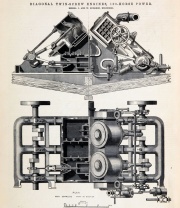J. and W. Dudgeon







J. and W. Dudgeon were shipbuilders and engine builders, of Millwall, later Cubitt Town.
John Dudgeon (1816-1881) and William Dudgeon (1818-1875) were blacksmiths from Scotland but gained experience with some of the leading engineering firms.
1855 John Dudgeon and his younger brother William established a marine engineering business at the Sun Ironworks, Millwall
1859 They founded an engineering shop at Millwall
1861 Started shipbuilding at Cubitt Town. One of the first vessels was the Thunder of 1,062 tons that reached the speed of 14 knots.
1861 Introduced propulsion by independently driven twin screws.[1]. The Dudgeons were the first to build any number of twin-screw vessels and to demonstrate their worth.
1862 Trials of SS Flora, the first twin-screw steamer having two independent engines (of 60 HP each). 400 tons, 160 ft long, 22.5 ft broad, 15.5 ft depth. Trials included a demonstration of turning in a circle with one engine running forward, the other in reverse. The tubular boiler arrangement was unusual. There was one boiler working at 30 psi and another at 50 psi. The latter supplied steam for the furnace blast and for mixing with the output from the low pressure boiler to dry the steam (and to superheat it?).
Built the Far East (launched 1863) and the Ruahine (launched 1865), the latter having twin screws and a compound engine.
1866 Launched HMS Waterwitch with 'waterjet' propulsion. See illustrations.
1871 Launched HMS Hecate.[2]
Employed about 2500 men
1875 The engine factory and shipyard closed
See Wikipedia for more information and a list of 70 ships built by the company.
See Also
Sources of Information
- ↑ The Engineer 1898/06/03
- ↑ The Engineer 1871/10/06 page 234.
A Short History of Naval and Marine Engineering by E. C. Smith. Published 1937

